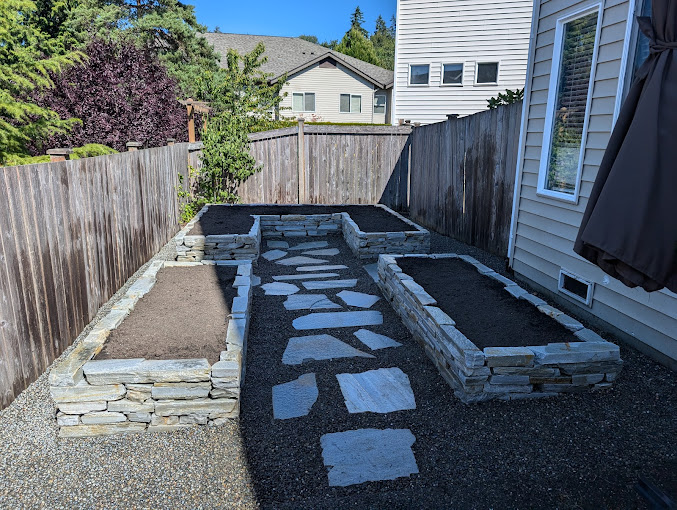Planter Wall Construction: Top Tips, Process, and the Benefits of Hiring a Professional Contractor
Building a planter wall on your Seattle property can greatly enhance the aesthetic and functionality of your outdoor space. Whether you’re looking to add a focal point to your garden, create a raised planting bed, or improve the structure of your landscape, a planter wall can be the perfect solution. However, constructing a planter wall requires careful planning, the right materials, and expertise. In this article, we’ll share the top tips for successful planter wall construction, guide you through the process, and explain the benefits of hiring a professional contractor.
Types and Styles of Planter Walls
The type of planter wall you choose depends on the design and functionality you need, as well as the specific conditions of your site. Here are some common types of planter walls, each with varying complexity and features:
| Type/Style | Complexity Level | Description |
|---|---|---|
| Reinforced Wall | Medium | Uses geogrid or reinforcement for added stability, ideal for taller or sloped areas. |
| Cantilevered Wall | Medium | Uses a cantilever design for added strength and support, often for taller walls. |
| Segmental Retaining Wall (SRW) | Medium | Uses interlocking blocks for a strong and flexible design, popular for retaining walls. |
| Modular Block Wall | Medium | Uses pre-fabricated blocks for a quick and easy installation, ideal for DIY and professional use alike. |
The Process of Planter Wall Construction
Building a planter wall requires a well-thought-out approach and the right materials. Here’s a step-by-step guide to the construction process:
1. Design and Planning
- The first step in creating a planter wall is the design phase. A professional contractor works with you to create a custom plan tailored to your property’s needs, climate, and landscape. During this stage, they will assess the wall’s purpose (such as drainage, aesthetics, or raised garden beds) and determine the best materials and construction methods.
2. Site Preparation
- Once the design is finalized, the contractor prepares the site by clearing the area and ensuring the ground is level and stable. This step is crucial to ensure the planter wall is built on a solid foundation that will prevent shifting or settling over time.
3. Material Selection and Delivery
- A key part of the construction process is choosing the right materials. The contractor selects high-quality, durable materials that are suitable for Seattle’s climate, taking into consideration factors like rainfall, wind, and temperature fluctuations. Once selected, the materials are delivered to the site for use in the construction.
4. Construction
- With the site prepared and materials in place, the contractor begins building the planter wall. This process involves laying the foundation, constructing the wall, and ensuring proper drainage. Proper drainage is crucial to prevent water accumulation behind the wall, which can cause damage or instability.
5. Finishing Touches
- The final stage involves adding the finishing touches to the planter wall, including planting the desired vegetation or adding decorative elements like stones, lights, or mulch. The contractor will ensure that the planter wall is not only functional but also visually appealing and complements your overall landscape design.
Benefits of Hiring a Professional Contractor for Planter Wall Construction
While you may consider building a planter wall on your own, there are several benefits to hiring a professional contractor:

| Benefit | Description | Importance Level |
|---|---|---|
| Expertise | A contractor has extensive knowledge of planter wall construction and the unique challenges of Seattle’s climate. | High |
| Time-Saving | Hiring a contractor saves you time and effort, allowing you to focus on other important tasks or enjoy your outdoor space. | Medium |
| Warranty | Reputable contractors offer warranties on their work, giving you peace of mind and ensuring long-term quality. | High |
| Increased Property Value | A well-built planter wall enhances the beauty and functionality of your property, boosting its overall value. | High |
| Safety | Contractors have the necessary training and equipment to safely handle heavy materials and construction tasks. | High |
Seattle-Specific Considerations
When constructing a planter wall in Seattle, it’s important to account for the region’s unique weather conditions and regulations. Here are a few Seattle-specific factors to consider:
- Rain and Wind Resistance:
- Seattle’s rainy and windy weather can put a strain on outdoor structures, so it’s essential to build a planter wall that can withstand these elements. Using durable materials, such as concrete blocks or reinforced stone, and ensuring a sturdy, properly-drained design will protect the wall from moisture and potential damage during high winds.
- Sustainable Options:
- Many homeowners are opting for more sustainable construction methods. Consider using recycled materials for your planter wall, such as reclaimed bricks or stones, or selecting drought-resistant plants that can thrive with minimal watering. Sustainable practices not only help the environment but can also reduce long-term maintenance costs.
- Integration with Existing Landscaping:
- A planter wall should complement your existing landscape design. Whether you’re using it to frame your garden, create a focal point, or add a layer of visual interest, the wall should work seamlessly with other features, such as pathways, patios, or decks. A contractor can help ensure that the design integrates with your property’s overall aesthetic and functional goals.
Conclusion
Building a planter wall is a great way to enhance the beauty and functionality of your outdoor space, whether you’re looking to create raised planting beds, improve drainage, or simply add structure and style to your garden. By following the top tips for successful planter wall construction and understanding the construction process, you can ensure a durable and attractive result. Hiring a professional contractor offers a host of benefits, including expertise, safety, and a high-quality finished product. For Seattle homeowners, contractors with local knowledge and experience can navigate the challenges of the region’s climate, helping you create a planter wall that stands the test of time.


















